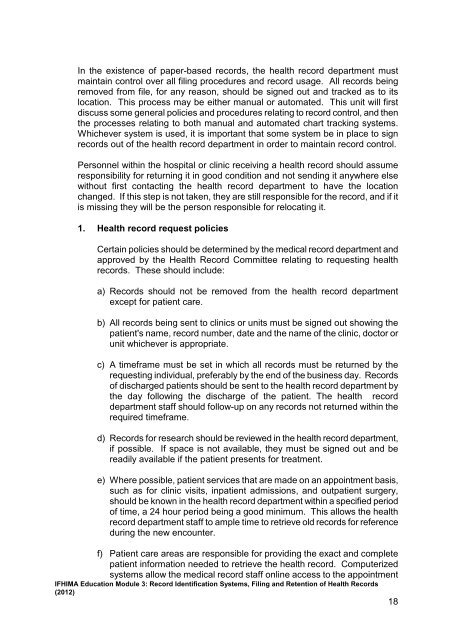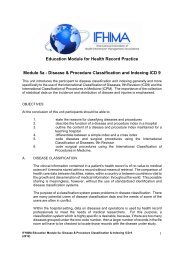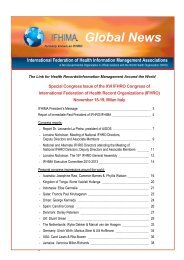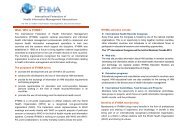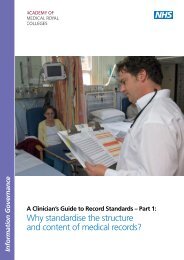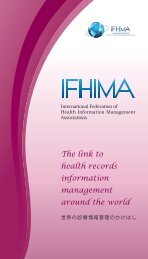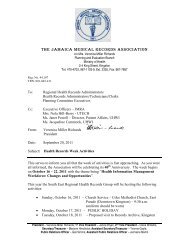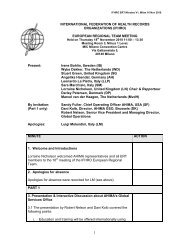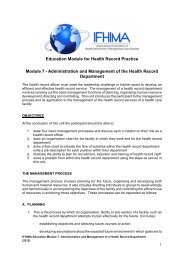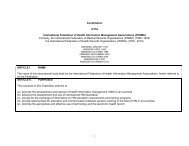Learning Packages for Medical Record Practice - ifhima
Learning Packages for Medical Record Practice - ifhima
Learning Packages for Medical Record Practice - ifhima
You also want an ePaper? Increase the reach of your titles
YUMPU automatically turns print PDFs into web optimized ePapers that Google loves.
In the existence of paper-based records, the health record department must<br />
maintain control over all filing procedures and record usage. All records being<br />
removed from file, <strong>for</strong> any reason, should be signed out and tracked as to its<br />
location. This process may be either manual or automated. This unit will first<br />
discuss some general policies and procedures relating to record control, and then<br />
the processes relating to both manual and automated chart tracking systems.<br />
Whichever system is used, it is important that some system be in place to sign<br />
records out of the health record department in order to maintain record control.<br />
Personnel within the hospital or clinic receiving a health record should assume<br />
responsibility <strong>for</strong> returning it in good condition and not sending it anywhere else<br />
without first contacting the health record department to have the location<br />
changed. If this step is not taken, they are still responsible <strong>for</strong> the record, and if it<br />
is missing they will be the person responsible <strong>for</strong> relocating it.<br />
1. Health record request policies<br />
Certain policies should be determined by the medical record department and<br />
approved by the Health <strong>Record</strong> Committee relating to requesting health<br />
records. These should include:<br />
a) <strong>Record</strong>s should not be removed from the health record department<br />
except <strong>for</strong> patient care.<br />
b) All records being sent to clinics or units must be signed out showing the<br />
patient's name, record number, date and the name of the clinic, doctor or<br />
unit whichever is appropriate.<br />
c) A timeframe must be set in which all records must be returned by the<br />
requesting individual, preferably by the end of the business day. <strong>Record</strong>s<br />
of discharged patients should be sent to the health record department by<br />
the day following the discharge of the patient. The health record<br />
department staff should follow-up on any records not returned within the<br />
required timeframe.<br />
d) <strong>Record</strong>s <strong>for</strong> research should be reviewed in the health record department,<br />
if possible. If space is not available, they must be signed out and be<br />
readily available if the patient presents <strong>for</strong> treatment.<br />
e) Where possible, patient services that are made on an appointment basis,<br />
such as <strong>for</strong> clinic visits, inpatient admissions, and outpatient surgery,<br />
should be known in the health record department within a specified period<br />
of time, a 24 hour period being a good minimum. This allows the health<br />
record department staff to ample time to retrieve old records <strong>for</strong> reference<br />
during the new encounter.<br />
f) Patient care areas are responsible <strong>for</strong> providing the exact and complete<br />
patient in<strong>for</strong>mation needed to retrieve the health record. Computerized<br />
systems allow the medical record staff online access to the appointment<br />
IFHIMA Education Module 3: <strong>Record</strong> Identification Systems, Filing and Retention of Health <strong>Record</strong>s<br />
(2012)<br />
18


